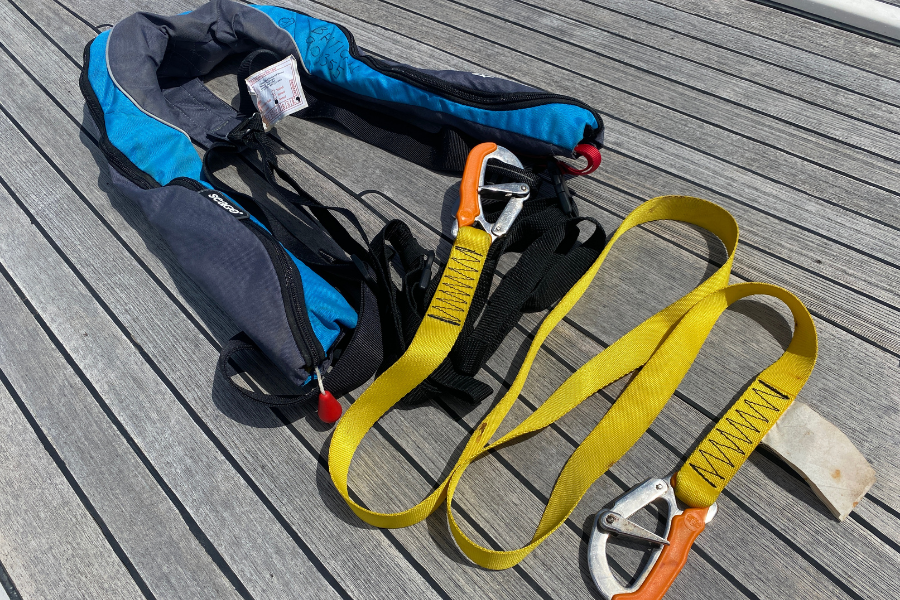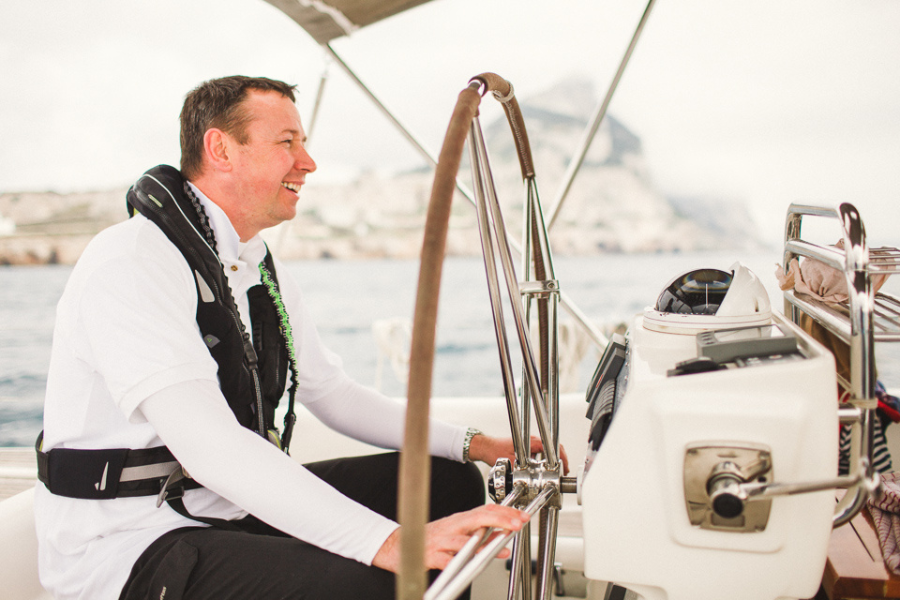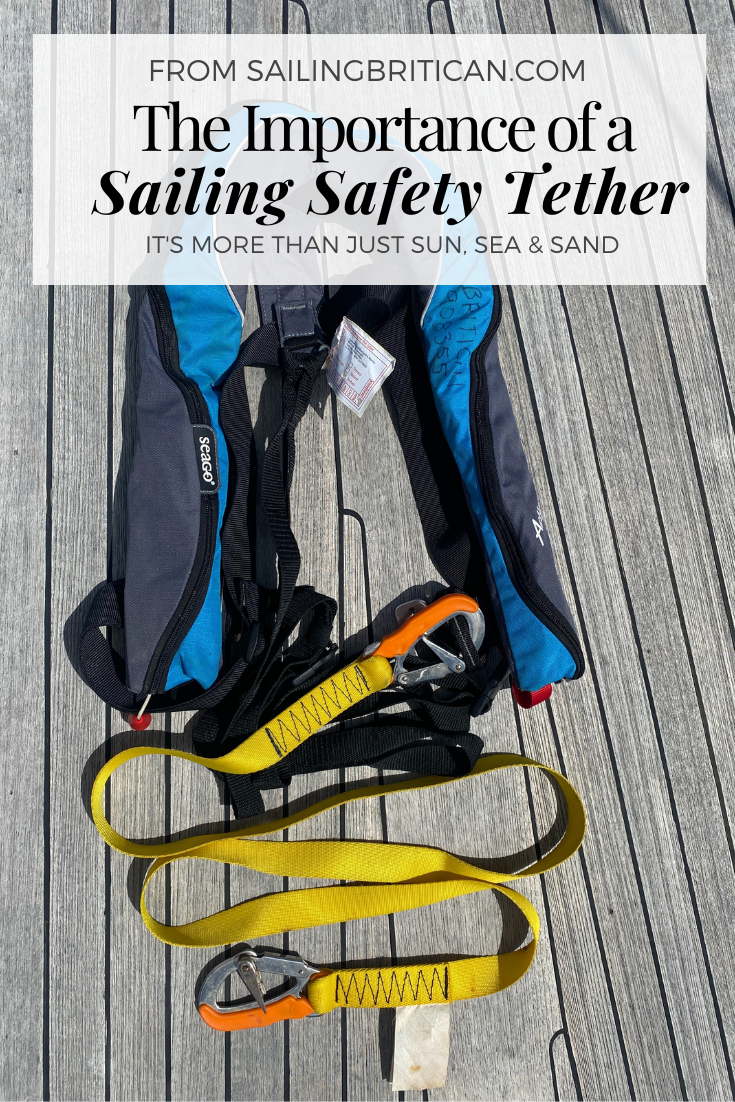A safety harness lanyard is a crucial piece of safety equipment for anyone venturing out on a boat. Think of it as your lifeline, a tether that connects your safety harness to a secure point on the boat. This simple yet essential device can prevent you from falling overboard in case of a slip or stumble.
Should you end up in the water, the lanyard becomes your lifeline, making it easier for others to pull you back on board. It offers a sense of security when moving around the boat, especially in rough conditions.
Lanyards come in various types, from fixed length to adjustable, and even shock-absorbing ones that reduce the impact force in case of a fall. Choosing the right lanyard is essential, so it’s always wise to consult with experienced sailors or boating safety experts to ensure you have the right gear for your adventures. A safety harness lanyard is not just an accessory; it’s an indispensable piece of equipment that could potentially save your life.

When we moved aboard Britican, all the safety harness lanyards that came with the boat’s sale had two connection points. One end clipped to my life jacket, and the other clipped to a point on the boat, a safety line, or a strong boat fitting.
Just before we crossed the Atlantic Ocean with the Atlantic Rally for Cruisers (ARC), we were ‘forced’ to purchase three-point tethers. Without the three-point safety harness lanyard, we would have failed our safety checks and wouldn’t have been permitted to sail with ARC.
At first, I thought it was just another added expense, but after using the three-point safety harness lanyard, I’m now very happy we have them. In addition to one clip on me, another on the boat, there’s a third for when you’re moving from one point to another. With three contact points, there’s never a situation when you’re not attached to the boat.
Using a Sailing Safety Tether – General instructions
You’d think using a tether would be a no-brainer, but it’s not always as easy as one might think. In some cases, boats do not have tether-ready connection points. If that’s the case, you can have them installed or find anything in the area to connect yourself to. Sometimes, it works best to put the tether through something and attach the clip to the safety harness lanyard itself.
Generally, however, most boats do have clipping areas in the cockpit. When exiting the cockpit to the aft, side, or foredeck, it’s important to clip your tether to a lifeline. Lifelines are usually temporary ropes or webbing that run the boat’s length along the deck.
Connect yourself to the next logical stronghold point once you get to where you’re going.
For example, when I go forward to the mast, I clip onto the lifeline (and unclip the other from the cockpit). I then carefully walk to the mast, making sure that my harness clip comes with me. It takes a bit of care to ensure the clip slides along the lifeline. Once I’m level with the mast, I clip my spare to the strongest thing I can find – in some cases, I wrap the line right around the mast and clip the tether itself. I then unclip from the lifeline.
The key with the tether is to make sure you’re clipped to something that will hold your body weight if you’re thrown away from the boat.

When do you need to use a safety harness lanyard?
That will come down to the life jacket and tether policy you decide upon. We don’t wear life jackets or tethers in calm sailing conditions. In calm seas, we don’t use tethers to go aft or forward when another crew member is watching. In the event that I’m alone in the cockpit and need to do something at the mast or near the bow of the boat, I’ll grab Simon to come up and keep an eye on me.
We, however, always use veststyle harnesses for general fall in stormy conditions and at night. We also always install our lifelines for long sailing passages.
Using a Safety Harness Lanyard – 7 Cruiser Tips
- Avoid paint chips and dings.
Whenever you’re wearing a life jacket but don’t need to tether yourself in, make sure to attach all clip points to a central location on your life jacket. The clip points are large and heavy. They’ll bang into things, perhaps chipping the gel coat, if you leave them dangling. - Save money.
In most cases, you’ll only ever have a couple of people at one time that needs to leave the cockpit. To save money, invest in a couple of three-point tethers and then buy the rest as two-point. Consider the most amount of people that would require a three-point tether at one time and buy that amount. - Use lifelines only when on passages.
Only put your lifelines out when you’re going to use them – especially if they’re made of a material that degrades in the sun. UV rays cause even the strongest webbing to deteriorate quickly. Similar to having sail covers, you want to ensure you’re lifelines are out of the sun when not in use. - Have a sailing knife.
Consider having a sailing knife on your belt or somewhere on your body. If a situation occurs where you need to cut the sailing safety tether, the knife will be invaluable. - Be organized.
Keep your tether connection points attached to your life jackets when storing. If you’re not going to need the tether, remove it and place it in storage. When you return your life jacket to storage refit the tether to ensure that it’s ready for use if needed in a hurry. - Keep a safety checklist.
Make sure you have a boat safety checklist outlining all of your safety equipment, where it’s located on the boat, and when it next needs to be serviced. Every time we use our tethers, just like all our safety equipment, we look for wear and tear. - Harnesses for the vertically challenged.
Many inflatable PFDs (Personal Flotation Devices) with built-in harnesses are designed for people taller than 5’6″ in height and are potentially dangerous if you are below that height. The attachment point of a harness must be above the lowest point of the rib cage. If it’s not, find a system that is. Look for harnesses for general fall arrest.
Make Sure Your SAFE Before Heading Out To Sea! Get our Boat Safety Audit checklist. Request access here: Boat Safety Audit or get our Boat Safety Checklists guide in our store.
Other Safety Related Articles & Videos
- Rescue At Sea: Watch a video where we showcase a real-life Man Overboard.
- The Best Life Jacket for Sailing Cruisers: Discover what you need to know about life jackets.
- Boat Safety – How To Keep Safe On The Water: Allow me to demystify boat safety for you.
- Three Things That All Liveaboards Must Know: Here are the top three safety things you must know.
- Safety Harness Lanyard’s on Amazon
Pin This Post on Pinterest – safety harness lanyard

Awesome read, and such an important subject to touch on! I, too, have heard stories of people falling overboard while still attached without being able to get back onto the deck. What an awful endeavor! The three-point system is surely the way to go – especially at night and during rough conditions, as you said. Reading this made me think of something I was working on recently regarding safety in the boat galley. How do you feel about cooking during a rough passage? Is it something you try to avoid, or do you have galley systems in place to ensure your safety? Specifically, I was reading a lot about the debate between safety rails and harness systems. People get pretty worked up about the topic, and I can see why! If you’re tethered in place in front of your stovetop while cooking hot food and your boat rolls, you’re unable to jump out of the way – often leading to burns and bruises. On the flip side, if you aren’t tethered in place, you can be easily thrown around the galley like a rag-doll. So, it begs the question – safety rails or harnesses in the boat galley when cooking during a rough passage? I would be super interested to hear your opinion on the subject! Thanks for the article, and keep up the good work as always!!
Hey Travis. Thank you for your comments. During short passages we usually just pull sandwiches out of the fridge or microwave something. On longer passages, I make the food up and we heat it in the oven. Usually I make a chili or a lasagna – something that is a one pot meal and easy to put in and take out of the oven. We then use very large bowls (I think they are dog bowls!) to plop the food in. There’s so much room that we’ve never had a spill. We’re fortunate because our galley is narrow. We can lean on our sink while using the oven/cooker. I often warn people about buying boats where the galley is open – if you’re going to be cooking on the go there is quite a bit of room for disaster. I would never boil water in heavy seas… It’s just a bit of common sense. Why take the risk when there are so many other things you can prepare ahead and just heat and eat. Smiles, Kim
Thanks for the reply, Kim! That’s kind of the response I was expecting. I guess it always pays to have a bit of common sense, but I suppose that also comes along with the experience you gain from sailing over time. The oversized serving bowls are a great tip for new sailors, I think. I also see a lot of value in your advice about the narrow galley – That has to be one of those things that get overlooked when buying a cruising boat for the first time. We would all be so lucky to have the knowledge and experience your family has gained over the years. All the best, and Ill look forward to seeing new content soon. Cheers!
Hi – I’m curious about your terminology here. You seem to be using “lifeline” to mean the same thing as “jackline” (this usage makes a ton of sense.)
What word do you use for the cables attached to the stanchions that run around the edge of the deck?
It’s a good question Caroline. Depending what country you’re in they use different words! I suppose I call the cables the ‘safety lines’. Another item that gets me too is the line from the life jacket to the boat – the tether? Some people call them life lines too. Kim